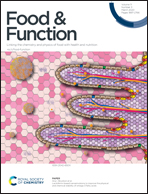 “Cannabis sativa is an aromatic annual flowering plant with several botanical varieties, used for different purposes, like the production of fibers, the production of oil from the seeds, and especially for recreational or medical purposes.
“Cannabis sativa is an aromatic annual flowering plant with several botanical varieties, used for different purposes, like the production of fibers, the production of oil from the seeds, and especially for recreational or medical purposes.
Phytocannabinoids (terpenophenolic compounds derived from the plant), include the well-known psychoactive cannabinoid Δ9-tetrahydrocannabinol, and many non-psychoactive cannabinoids, like cannabidiol.
The endocannabinoid system (ECS) comprises of endocannabinoid ligands, enzymes for synthesis and degradation of such ligands, and receptors. This system is widely distributed in the gastrointestinal tract, where phytocannabinoids exert potent effects, particularly under pathological (i.e., inflammatory) conditions.
Herein, we will first look at the hemp plant as a possible source of new functional food ingredients and nutraceuticals that might be eventually useful to treat or even prevent gastrointestinal conditions.
Subsequently, we will briefly describe the ECS and the general pharmacology of phytocannabinoids. Finally, we will revise the available data showing that non-psychoactive phytocannabinoids, particularly cannabidiol, may be useful to treat different disorders and diseases of the gastrointestinal tract.
With the increasing interest in the development of functional foods for a healthy life, the non-psychoactive phytocannabinoids are hoped to find a place as nutraceuticals and food ingredients also for a healthy gastrointestinal tract function.”
https://www.ncbi.nlm.nih.gov/pubmed/32357565
https://www.mdpi.com/1422-0067/21/9/3067


 “Borderline Personality Disorder (BPD) is a chronic debilitating psychiatric disorder characterized mainly by emotional instability, chaotic interpersonal relationships, cognitive disturbance (e.g. dissociation and suicidal thoughts) and maladaptive behaviors. BPD has a high rate of comorbidity with other mental disorders and high burden on society.
“Borderline Personality Disorder (BPD) is a chronic debilitating psychiatric disorder characterized mainly by emotional instability, chaotic interpersonal relationships, cognitive disturbance (e.g. dissociation and suicidal thoughts) and maladaptive behaviors. BPD has a high rate of comorbidity with other mental disorders and high burden on society.
 “Over the last two decades, affirmative diagnoses of osteoarthritis in the United States have tripled due to increasing rates of obesity and an aging population.
“Over the last two decades, affirmative diagnoses of osteoarthritis in the United States have tripled due to increasing rates of obesity and an aging population. “The pathophysiological relevance of the endocannabinoid system has been widely demonstrated in a variety of diseases including cancer, neurological disorders, and metabolic issues. Therefore, targeting the receptors and the endogenous machinery involved in this system can provide a successful therapeutic outcome.
“The pathophysiological relevance of the endocannabinoid system has been widely demonstrated in a variety of diseases including cancer, neurological disorders, and metabolic issues. Therefore, targeting the receptors and the endogenous machinery involved in this system can provide a successful therapeutic outcome. “Hempseed (Cannabis sativa L.) has beneficial impact on human health mainly because of its wide variability of bioactive compounds. However, many of them are not fully characterized yet. In this work, hempseed was defatted and through a bio-guided studied, two fractions (F03 and F05) with the highest content of phenols, flavonoids and antioxidant capacity were selected. Fractions were chemically analyzed by UHPLC HRMS/MS. The anti-inflammatory capacities of these compounds were evaluated on human monocytes using flow cytometry, RT-qPCR and Elisa procedures. A high amount of phenolic compounds were identified, with the major compound being: N-trans-caffeoyltyramine (6.36 mg g-1 in F05 and 1.28 mg g-1 in F03). Both, F03 and F05 significantly reduced the inflammatory competence of LPS-treated human primary monocytes, decreasing TNF-α and IL-6 gene expression and secretion. These findings indicate that in the defatted fraction of the hempseed there are a wide number of compounds with beneficial potential to prevent and treat inflammatory disorders, as well as other processes caused by oxidative stress.”
“Hempseed (Cannabis sativa L.) has beneficial impact on human health mainly because of its wide variability of bioactive compounds. However, many of them are not fully characterized yet. In this work, hempseed was defatted and through a bio-guided studied, two fractions (F03 and F05) with the highest content of phenols, flavonoids and antioxidant capacity were selected. Fractions were chemically analyzed by UHPLC HRMS/MS. The anti-inflammatory capacities of these compounds were evaluated on human monocytes using flow cytometry, RT-qPCR and Elisa procedures. A high amount of phenolic compounds were identified, with the major compound being: N-trans-caffeoyltyramine (6.36 mg g-1 in F05 and 1.28 mg g-1 in F03). Both, F03 and F05 significantly reduced the inflammatory competence of LPS-treated human primary monocytes, decreasing TNF-α and IL-6 gene expression and secretion. These findings indicate that in the defatted fraction of the hempseed there are a wide number of compounds with beneficial potential to prevent and treat inflammatory disorders, as well as other processes caused by oxidative stress.” “Hemp (Cannabis sativa L.) has become widely used in several sectors due to the presence of various bioactive compounds such as terpenes and
“Hemp (Cannabis sativa L.) has become widely used in several sectors due to the presence of various bioactive compounds such as terpenes and  “Cannabis Indica Speeds up Recovery from Coronavirus Severe acute respiratory syndrome (SARS) is a viral respiratory disease caused by the SARS coronavirus (SARS-CoV).
“Cannabis Indica Speeds up Recovery from Coronavirus Severe acute respiratory syndrome (SARS) is a viral respiratory disease caused by the SARS coronavirus (SARS-CoV).